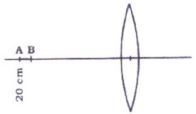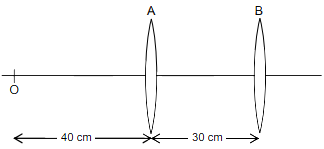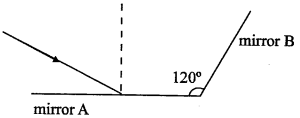A beam of light coming from a rarer medium is partially reflected from the surface of a denser medium and partially refracted into the denser medium. If the reflected and the refracted rays are perpendicular to each other and the ratio of the refractive indices of the denser and rarer medium is , the angle of refraction will be -
1.
2.
3.
4.

To unlock all the explanations of 14 chapters you need to be enrolled in MasterClass Course.

To unlock all the explanations of 14 chapters you need to be enrolled in MasterClass Course.
A person can see clearly only the objects situated in the range of 50 cm to 300 cm. He went to an optometrist who prescribed him a lens of a certain power to increase the maximum distance of his vision to infinity, i.e., it corrected the nearsightedness. However, upon using the prescribed lens the person discovered that the near point of his vision has shifted from 50 cm to a distance "d". What is the value of d?
1. 60 cm
2. 100 cm
3. 40 cm
4. 500 cm

To unlock all the explanations of 14 chapters you need to be enrolled in MasterClass Course.

To unlock all the explanations of 14 chapters you need to be enrolled in MasterClass Course.
A convex lens and a concave lens, each of focal length 10 cm, are kept separated by a distance of 2 cm as shown in the figure. If the light is incident from left, the combinations of lenses will be _____.

1. Converging
2. Diverging
3. Behaving like a glass slab
4. Converging or diverging depending on whether the lenses are arranged as shown in the figure
or in the reverse order.

To unlock all the explanations of 14 chapters you need to be enrolled in MasterClass Course.

To unlock all the explanations of 14 chapters you need to be enrolled in MasterClass Course.
A pin AB of length 2 cm is kept on the axis of a convex lens between 18 cm and 20 cm as shown in figure. Focal length of convex lens is 10 cm. Find magnification produced for the image of the pin.

1. 0.83
2. 1.00
3. 1.25
4. 6.78

To unlock all the explanations of 14 chapters you need to be enrolled in MasterClass Course.

To unlock all the explanations of 14 chapters you need to be enrolled in MasterClass Course.
A person is suffering from both nearsightedness and farsightedness. His spectacles would be made up of:
1. two convex lenses with the upper lens having a larger focal length than that of the lower lens.
2. two concave lenses with the upper lens having a smaller focal length than that of the lower lens.
3. a concave lens as the upper lens and a convex lens as the lower lens
4. a convex lens as the upper lens and a concave lens as the lower lens

To unlock all the explanations of 14 chapters you need to be enrolled in MasterClass Course.

To unlock all the explanations of 14 chapters you need to be enrolled in MasterClass Course.
Two convex lens A and B, each of focal length 30 cm are separated by 30 cm, as shown in the figure. An object O is placed at a distance of 40 cm to the left of lens A.

What is the distance of the final image formed by this lens system?
1. 120 cm to the right of lens A
2. 90 cm to the right of lens A
3. 22.5 cm to the right of lens B
4. 45 cm to the right of lens B

To unlock all the explanations of 14 chapters you need to be enrolled in MasterClass Course.

To unlock all the explanations of 14 chapters you need to be enrolled in MasterClass Course.
In order to get an upright image, photographic slides must be placed upside down in a slide projector. What type of lens must the slide projector have?
1. concave
2. convex
3. plane
4. both a and b

To unlock all the explanations of 14 chapters you need to be enrolled in MasterClass Course.

To unlock all the explanations of 14 chapters you need to be enrolled in MasterClass Course.
Two plane mirrors are placed at a angle with respect to each other. A ray of light is incident upon mirror A at an angle of and is reflected toward mirror B. At what angle of reflection does the ray leave the surface of mirror B?

1.
2.
3.
4.

To unlock all the explanations of 14 chapters you need to be enrolled in MasterClass Course.

To unlock all the explanations of 14 chapters you need to be enrolled in MasterClass Course.
A 20 cm object is placed 15 cm in front of a converging lens with a focal length of 10 cm. What is the height and location of the image created by the lens?
1. The image is 10 cm in size and is located 30 cm behind the lens.
2. The image is 10 cm in size and is located 20 cm behind the lens.
3. The image is 20 cm in size and is located 20 cm behind the lens.
4. The image is 40 cm in size and is located 30 cm behind the lens.

To unlock all the explanations of 14 chapters you need to be enrolled in MasterClass Course.

To unlock all the explanations of 14 chapters you need to be enrolled in MasterClass Course.
A child stands between two mirrors with his arms out, perpendicular to the mirrors. One plane mirror is 5 m away from his left hand and another plane mirror is 7 m away from his right hand. How far apart are the two images produced by the mirrors if the child has an arm span of 0.5 m?
1. 2 m
2. 12 m
3. 12.5 m
4. 24.5 m

To unlock all the explanations of 14 chapters you need to be enrolled in MasterClass Course.

To unlock all the explanations of 14 chapters you need to be enrolled in MasterClass Course.






